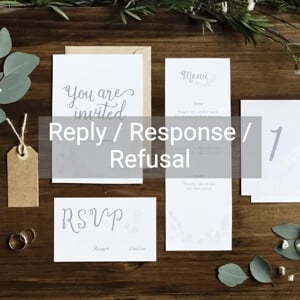Party / Housewarming / Birthday Invitation Letter


There are many types of invitations one could send, for example, a birthday invitation or a housewarming invitation. In general, there are two types of party invitations, formal and informal invitations.
These are generally for formal events such as receptions, dinners, weddings, banquets, etc. where the invitations are engraved or printed on a card - usually written in the third person with an R.S.V.P. notation. Should you wish to include a personal message, it can be written on the card or on a separate sheet of paper.
These invitations can be more personal and sincere. You can include anything in your message. Usually, party invitations such as a birthday or housewarming invitation would fall within the latter category, which would allow the host to be more creative. Writing party invitations can be a daunting task, but you can master this art through some skills and practice.
A formal invitation is normally in a set format with little to no room for creative drafting (please refer to “Invitation” under the “General Business” section).
The following information relates to the drafting of a causal invitation. Although you can be as creative as you like in a casual invitation, please ensure you have the following:
The first thing to include in an invitation is the name of the party hosting the event or in whose name the event is being held. If the invitee is not familiar with the host or does not even know who the guest of honour is, he or she may not respond to the invitation. For example, if it is a birthday invitation letter, be sure to include the name of the birthday person. If it is a housewarming invitation message, be sure to include the host of the new home.
The host can be the same as the guest of honour – e.g. Ryan’s Housewarming party or they can be different people – e.g. Ryan’s girlfriend Meg is holding a surprise party for Ryan’s 30th birthday. In most cases, the invitees to the party are likely to be friends and relatives of the guest of honour, so there is no need to introduce him/her in the invitation. However, where the host is not the same person as the guest of honour, you may want to introduce the host as well as the relationship between the host and the guest of honour (see the example above).
Next is to decide who to invite. You should identify who you are inviting and whether the invited guests could bring their spouses, children, and other members of their family. You may want to invite your guest “on an exclusive basis” and remind them not to bring other guests. Make sure your venue has enough capacity to cater to all the invitees in case everybody accepts your invitation. Please also ensure that you explicitly include a phrase to “invite” the recipient of the invitation. It may look impolite and insincere to send invitations to people with the venue, time, and date but without actually inviting them to attend. Depending on the situation, an invitation letter should be sent 2 to 8 weeks in advance to allow your guests sufficient time to save the date and mark their calendars.
Explain the purpose of the invitation. You should tell your guests what you are celebrating so that they know what to expect and if necessary bring an appropriate gift. For example, a birthday present will be different from a housewarming present. Don't be afraid to mention details, such as the age of the birthday person, especially if it is a milestone birthday.
By including all the facts about your party, guests will have an easier time deciding whether they can accept the invitation and reach the event at the right place at the right time. Include the date of the party as well as the day of the week and be very specific on the time. Don’t just say Sunday afternoon as your guests will not know when to arrive – your invitation needs to tell your guests when to arrive, and if there is a specific end time, indicate that time on the invitation. You don’t want to have one guest arriving at 1.30 and the other arriving at 5.30.
Remember to tell your guests where the event will be held. Regardless of whether the party is held - in someone’s home, a restaurant, club, or elsewhere, you need to provide the full name and address of the venue. Never assume that guests know where the host's home is, or where a restaurant is. If your guests are unfamiliar with the meeting place, include instructions or a Google Maps location on the invitation. Providing clear and detailed instructions on how to get to the venue may seem obvious, but the wording of a party invitation is crucial to the presence of the guests.
The wording of your invitation letter should include the dress code for the type of event that you are organising. For a formal event held at an upscale restaurant or hotel, it could be a black tie. For a cocktail, it could be business casual. If the party is a masquerade, the guests need to be prepared to come with a theme. For a pool party, guests should bring swimming costumes and towels. Thus it is important to give advanced notice to guests on what to wear or what to bring to the event.
You can show whether you will be providing food and drinks by indicating the type of party in the invitation – for example, a dinner party or a cocktail party. Otherwise, you can inform your guests on whether food, snacks, canapes, drinks, or other refreshments will be provided so that the guests will know whether to come hungry or full. This is also important if your guests want to bring something to the party. You can ask your guests if they have any food allergies or any special dietary requirements.
You may want your guests to respond to your event and let you know if they will attend. Give them a date they need to reply by. Also, include in the invitation letter instructions on how to respond. You might include a phone number, email address, or response card for them to respond through. Knowing who and how many guests can come to the party is a great help to the host's preparation. It helps to estimate the amount of food and drinks, as well as details of seating arrangements, and gift bags required for the occasion.
On a child's birthday invitation letter, you can tell parents if they need to leave or stay. You may want to ask other parents to stay by getting them to RSVP. If you want to send the parents away, you can simply state in your birthday invitation letter, "Please pick up your child at 6 pm."






Not the right document?
Don’t worry, we have thousands of documents for you to choose from: